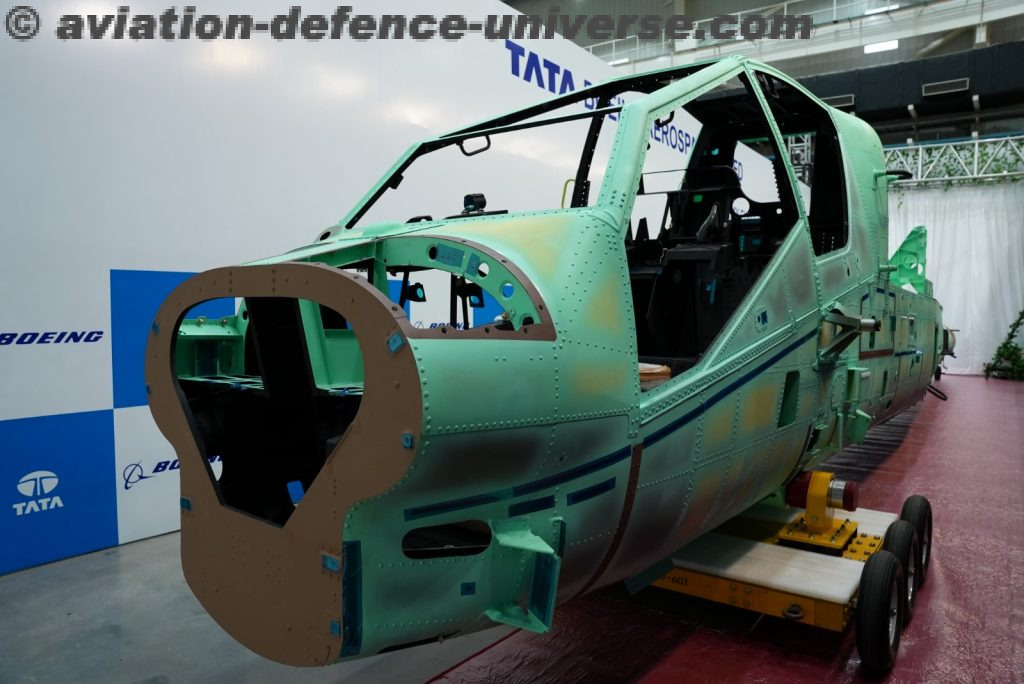New Delhi. 20 December 2023. Tata Boeing Aerospace Limited (TBAL) has delivered the 250th fuselage for the AH-64 Apache attack helicopter from its state-of-the-art facility in Hyderabad. These fuselages are manufactured for customers around the world, including the U.S. Army, and most recently, the six on order with the Indian Army. This milestone reflects TBAL’s continuous dedication to bolstering India’s defence capabilities and advancing the nation’s indigenous manufacturing prowess.
The joint venture between Boeing and Tata Advanced Systems Limited (TASL) employs over 900 engineers and technicians, leveraging cutting-edge robotics, automation, and advanced aerospace concepts in its manufacturing processes. TBAL’s 14,000 sqm facility serves as a global sole source supplier for Apache fuselages, with over 90 percent of the parts used in the Apache aerostructure assemblies manufactured in India through more than 100 Micro, Small, and Medium Enterprises (MSME) suppliers.
Let’s now examine the kind of fuselage that the country is discussing. The fuselage, which is the central section of an aircraft or helicopter, is named after the French verb “fuseler,” which means “to streamline.” The fuselage is joined to the wing and tail assemblies. It is the main body section of an aircraft, housing the engine, gearbox, avionics, flight controls, and powerplant in addition to the cabin, which accommodates the crew, passengers, and cargo.
Being the main structural component of a helicopter, the fuselage needs to be robust and aerodynamic in order to withstand the forces generated during flight. It is most affected by the five stress factors—tension, compression, bending, shear, and torsion—that are present during flight. The air resistance force is the cause of these stresses. Drag, the resistance a helicopter encounters, particularly during forward flight, is largely determined by the fuselage’s shape. A fuselage experiences less drag the more streamlined it is. The fuselage of the Apache is incredibly streamlined. It gives the aircraft its shape and provides the aerodynamics required for the intended flight path. It acts as a base of assembly for the various aircraft components.
Aluminium alloys that are forged or extruded and fastened together with steel, titanium, and aluminium are used to construct modern helicopter fuselages.The fundamental framework of the fuselage is composed of frames and stringers. The loads imposed by pressurisation are carried by pressure bulkheads, which close the pressure cabin at both ends of the fuselage. They could resemble curved bowls or flat discs. The Apache’s fuselage is 49 feet 5 inches (15.06 metres) long. Similar to fixed-wing aircraft, helicopter tail booms and fuselages are frequently stress-skin designed truss-type or semimonocoque structures. Aluminium skin, formed aluminium, and steel and aluminium tubing are frequently utilised. Advanced composites are also being used more and more in modern helicopter fuselage design. Typically, engine decks and firewalls are made of stainless steel. fuselages of helicopters
Aluminium skin, formed aluminium, and steel and aluminium tubing are frequently utilised. Advanced composites are also being used more and more in modern helicopter fuselage design. Typically, engine decks and firewalls are made of stainless steel. Larger twin-engine helicopters have fully enclosed airplane-style cabins, while smaller helicopters have a monocoque shell flight compartment, two seats, no doors, and a truss frame. Because helicopter flight is multidirectional, having wide-angle visibility from the cockpit is crucial. Large, formed windscreens made of glass, plexiglass, or polycarbonate are typical.
The story of Apache AH-64E will continue in India and so will the tie up between Tata and Boeing which has a futuristic plan to use the facility in times to come. But at the end of the day it is a relationship between two important countries which is marching ahead with elan’.
































































































































